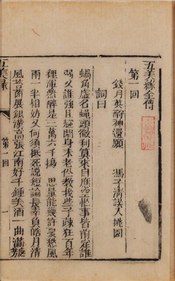
Wu Mei Yuan[1] or Wumei yuan[2] (traditional Chinese: 五美緣; simplified Chinese: 五美缘), translated into English as the Destinies of Five Beauties,[3] is a Chinese romantic novel of the early 19th-century during the Qing dynasty. The novel is usually categorized as one of the caizi jiaren novels. Its authorship is ascribed to a writer named Jisheng Shi (寄生氏), which is a pseudonym, however, this is also disputed.[4] It consists of 80 chapters. An early printed edition of the novel dating to 1822 is located in the National Library of China.
Citations
[edit]- ^ Wang, Qingping (1998). The Commercial Production of the Early Qing Scholar-beauty Romances. Stanford University. p. 35.
Wu Mei Yuan 五美緣. 80 chapters. Preface by Jisheng Shi 寄生氏. Renwu 壬午, (1822).
- ^ Salmon, Claudine, ed. (2013). Literary Migrations: Traditional Chinese Fiction in Asia (17th-20th Centuries). Institute of Southeast Asian Studies. p. 144. ISBN 9789814414326.
- ^ Brokaw, Cynthia J. (2020). Commerce in Culture: The Sibao Book Trade in the Qing and Republican Periods. Brill. p. 497.
- ^ "《五美缘》". 《中国大百科全书》第三版网络版 (in Chinese).
Well, that’s interesting to know that Psilotum nudum are known as whisk ferns. Psilotum nudum is the commoner species of the two. While the P. flaccidum is a rare species and is found in the tropical islands. Both the species are usually epiphytic in habit and grow upon tree ferns. These species may also be terrestrial and grow in humus or in the crevices of the rocks.
View the detailed Guide of Psilotum nudum: Detailed Study Of Psilotum Nudum (Whisk Fern), Classification, Anatomy, Reproduction